George Tattersall Paintings
George Tattersall was an English artist, architect, and illustrator best known for his depictions of sporting and animal subjects. Born in 1817, he was active during the early Victorian era, a period of significant social, economic, and technological change in Britain. Tattersall's work reflects the growing interest in sporting culture among the British gentry and middle classes during the 19th century.
Tattersall's talent for drawing and painting emerged early, and he cultivated his skills primarily through self-instruction. He was particularly passionate about horses, which became a central theme in his artistic work. In addition to painting, Tattersall was also involved in architectural design, though it is his illustrations that garnered him the most recognition.
Throughout his career, Tattersall contributed illustrations to various sporting and wildlife publications. His detailed and dynamic images captured the movement and vitality of his subjects, earning him a dedicated following. He also published his own works, including 'The Pictorial Gallery of English Race Horses' (1844), which contained portraits of notable racehorses of his time along with essays on their history and achievements.
Despite his contributions to British sporting art, Tattersall’s life was relatively short. He died in 1849 at the age of 32. His legacy is preserved through his published works and the continued appreciation of his illustrations in the context of Victorian art and culture. Tattersall’s work provides important insight into the sporting life of the era and remains of interest to collectors and historians of equine art.
